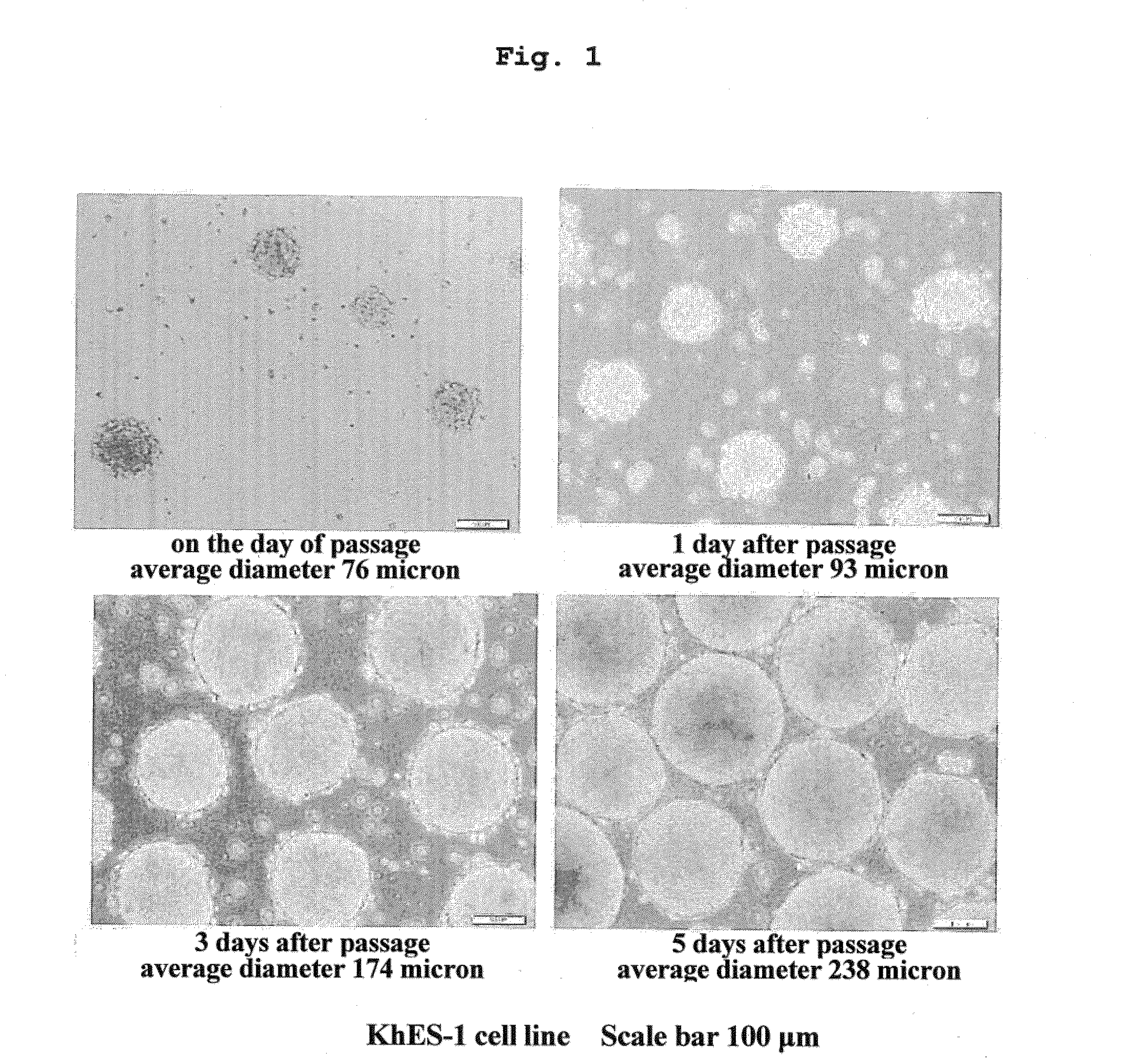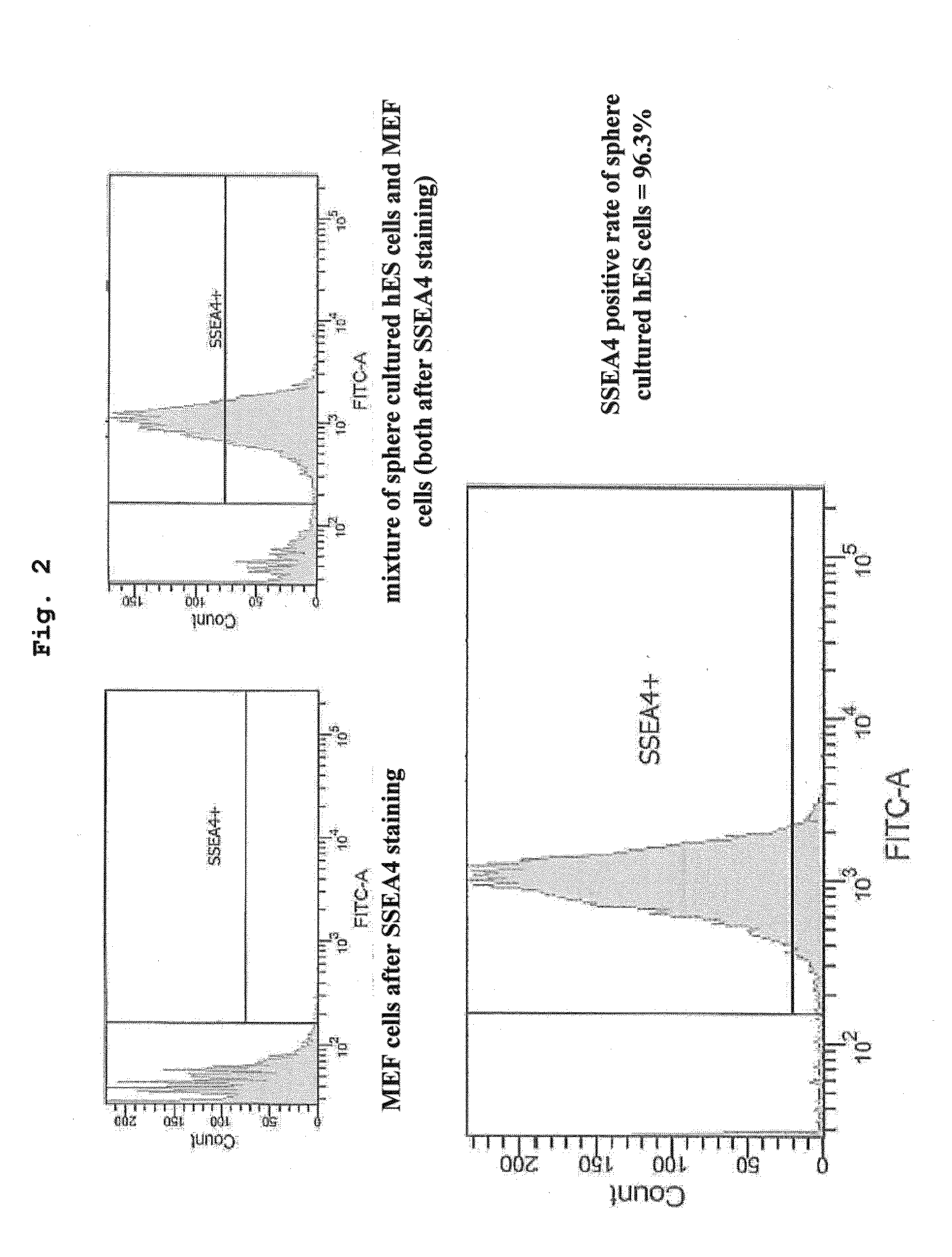Method for culturing pluripotent stem cell
a technology of pluripotent stem cells and culturing methods, which is applied in the field of maintaining and amplifying pluripotent stem cells, can solve the problems of complex multi-step handling, limitation of conventional methods including adhesion to a culture vessel and growth by passage, and inability to stably culturing and growing high-quality human pluripotent stem cells in large amounts, etc., to achieve easy control of the size of cell aggregates, facilitate the control of cell aggregates
- Summary
- Abstract
- Description
- Claims
- Application Information
AI Technical Summary
Benefits of technology
Problems solved by technology
Method used
Image
Examples
example 1
Preliminary Consideration of Methylcellulose Concentration
[0107]As a preliminary experiment, hES cell line KhES-1 was cultured in medium 1 and medium 2 containing 0.25%, 0.28% or 0.5% (w / v) methylcellulose. Fusion of cell spheres could be prevented most efficiently in the concentration of 0.28 w / v % methylcellulose (fusion rates of 1.0%, 1.1%, 1.3% and 1.6% in 4 measurements; 8-13 are fusion spheres in 722-978 spheres in total). In the experiments thereafter, 0.28 w / v % methylcellulose-containing medium was used unless otherwise specified.
example 2
Preliminary Consideration of Mesh Size
[0108]As a mesh to be used at passage, a CellTrics filter having a pore size of 50 μm and a cell strainer having a pore size of 40 μm were compared. Since the mesh having a pore size of 50 μm showed superior cell proliferation effect, in later experiments, a mesh having a pore size of 50 μm was used unless otherwise specified.
example 3
Suspension Sphere Culture of Human ES Cell Line KhES-1 (up to 20 Passages)
[0109]Using medium 1 and medium 2 containing 0.28 w / v % methylcellulose, and CellTrics filter having a pore size of 50 μm as a mesh, suspension sphere culture of KhES-1 cell line was performed up to 20 passages according to the procedure described in the aforementioned [Method]. The results are shown in Table 1.
TABLE 1Record of suspension sphere cultureof KhES-1 cells in long- term passagestandardpassage numbernumberaveragedeviation(left) andof dayssphereof spherenumber ofsplitsphere numberafterdiameterdiameterspheresratio(right)passage(μm)(μm)measuredP11 d88.21±13.84n = 37 3 d146.4±22.38n = 90 5 d232.36±25.73n = 101X 2P21 d106.46±17.41n = 27 3 d166.63±29.22n = 75 5 d235.6±27.19n = 88 X 3P31 d95.93±19.20n = 1123 d167.26±32.79n = 1559085 d247.41±33.17n = 98 X 6P41 d93.7±15.55n = 77 3 d174.17±34.23n = 1277485 d238.7±38.00n = 120X 8P51 d109.46±19.62n = 1423 d177.76±29.13n = 1288205 d236.35±40.00n = 107X 9P61 d94....
PUM
| Property | Measurement | Unit |
|---|---|---|
| diameter | aaaaa | aaaaa |
| diameter | aaaaa | aaaaa |
| diameter | aaaaa | aaaaa |
Abstract
Description
Claims
Application Information
 Login to View More
Login to View More - R&D
- Intellectual Property
- Life Sciences
- Materials
- Tech Scout
- Unparalleled Data Quality
- Higher Quality Content
- 60% Fewer Hallucinations
Browse by: Latest US Patents, China's latest patents, Technical Efficacy Thesaurus, Application Domain, Technology Topic, Popular Technical Reports.
© 2025 PatSnap. All rights reserved.Legal|Privacy policy|Modern Slavery Act Transparency Statement|Sitemap|About US| Contact US: help@patsnap.com



